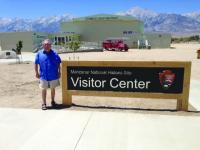
Here is a recent (Saturday!) photo of CT contributer, Sam Ghaleb, at the Manzanar "Relocation Center," located in the California desert.
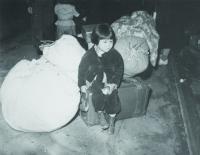
A young evacuee of Japanese ancestry waits with the family baggage before leaving by bus for an assembly center.
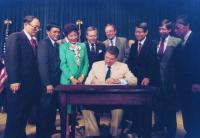
Ronald Reagan signing Japanese reparations bill.
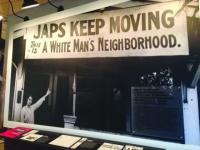
Photo at Manzanar museum of a storefront sign exhibiting the racism prevalent at that time.
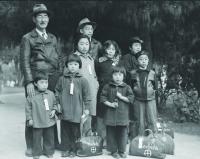
Members of the Mochida family awaiting evacuation and internment.
THIS WEEK, 70 years ago, the Supreme Court of the United States issued opinions in two cases - Hirabayashi v. United States, 320 U.S. 81, 84, 92 (1943) and Yasui v. United States, 320 U.S. 115, 116, 117 (1943). Mr. Chief Justice Harlan Fiske Stone authored both for a unanimous Court, although there were three short concurring opinions in Hirabayashi.
Both Gordon Hirabayashi and Minoru Yasui were citizens of this country, born in the United States, of Japanese parents. Mr. Hirabayashi was born in Seattle in 1918, had never been to Japan and, " . . . was educated in the Washington public schools and, at the time of his arrest, was a senior in the University of Washington . . .."
Mr. Yasui was born in Oregon in 1916, " . . . attended the public schools . . ., attended the University of Oregon, from which he received A.B. and L.L.B. Degrees; ... was a member of the Bar of Oregon, and a second lieutenant in the Army of the United States, Infantry Reserve; ... had been employed by the Japanese Consulate in Chicago, but had resigned on December 8, 1941, and immediately offered his services to the [U.S.] military authorities . . .."
On December 7, 1941, Japanese Pilot Shigenori Nishikaichi had crash-landed his Zero on a small island named NiÙihau in the Hawaiian Islands chain. Since the Native Hawaiians living on the small island could not understand the Japanese pilot, they sent for their neighbor Ishimatsu Shintani, who had been born in Japan but was married to a Native Hawaiian, to translate. At the time, the Hawaiians did not know that the Japanese had attacked Pearl Harbor. When the two Japanese spoke in their native tongue, Mr. Shintani realized there could be a big problem and quickly left. The Hawaiians - still in the dark - did not understand and sent for Mr. and Mrs. Yoshio Harada, who, although born in Hawaii, were of Japanese ancestry and spoke Japanese. The first Hawaiian on the scene, Hawila Kaleohano, had retrieved the pilotÙs papers, which being in Japanese, were indecipherable to him. The pilot desperately wanted to retrieve them, but Mr. Kaleohano would not release them. Ultimately, the Hawaiians learned of the attack and kept the pilot under guard. It was at that point that Mr. and Mrs. Harada lost their mind and attempted to free the pilot, attacking and overpowering the lone guard who had been posted outside of their residence. They then proceeded to Mr. KaleohanoÙs house to retrieve the documents. The upshot was that the escape attempt failed, the pilot was killed and another Hawaiian - Bene Kanahele - seriously wounded. But there it was - Americans of Japanese heritage had turned on their country and assisted the enemy, which had just completed its, "...unprovoked and dastardly attack..." on the United States of America.
President Franklin Delano Roosevelt signed Executive Order 9066, on February 19, 1942, which authorized Military Commanders to designate "military areas" at their discretion "from which any or all persons may be excluded." Executive Order 9066 had come at the instances of General John L. DeWitt, Military Commander of the Western Defense Command and California Attorney-General Earl Warren, who would later be elected Governor of that state and later still appointed Chief Justice of the Supreme Court. General DeWitt had reported to the President that, although no acts of sabotage - or terrorism as it would now be called - by Japanese-Americans had been confirmed, this only proved, "... a disturbing and confirming indication that such action will be taken." As a result of the Order, ultimately, all Japanese and Japanese-Americans were removed from the coastal areas of California, Oregon and Washington, and placed in internment camps.
Congress enacted legislation, on March 21, 1942, that made, " . . . it a misdemeanor knowingly to disregard restrictions made applicable by a military commander to persons in a military area prescribed by him as such, all as authorized by an Executive Order of the President." In testimony before Congress, in support of the legislation, General DeWitt said,
"I donÙt want any of them [persons of Japanese ancestry] here. They are a dangerous element. There is no way to determine their loyalty . . . it makes no difference whether he is an American citizen. He is still a Japanese. American citizenship does not necessarily determine loyalty . . .. But we must worry about the Japanese all the time until he is wiped off the map."
On March 24, 1942, General DeWitt issued Public Proclamation No. 3, which declared an 8:00 p.m. - 6:00 a.m. curfew for, "...all enemy aliens and all persons of Japanese ancestry," within the military areas. Both Mr. Hirabayashi and Lt. Yasui were charged with violating that curfew. Mr. Hirabayashi was also charged with failing, " . . . to report to the Civil Control Station on May 11 or May 12, 1942, as directed, to register for evacuation from the military area." On May 3, 1942, General DeWitt had issued Civilian Exclusion Order No. 34, ordering all people of Japanese ancestry, whether citizens or non-citizens, to report to assembly centers for transport to the camps. Mr. Hirabayashi was convicted on both counts and received a sentence of three (3) months for each count, the sentences to run concurrently. Instead of accepting his offer of service to his country, Lt. Yasui was sentenced to one year in prison.
The Hirabayashi Court based its decision on the GovernmentÙs power to wage war, saying that the Congressional Act and the Executive Orders, " . . . were each an exercise of the power to wage war conferred on the Congress and on the President as Commander-in-Chief of the Armed Forces, by Articles I and II of the Constitution." The holding and language of Hirabayashi would go on to form part of the foundation of the Bush-era philosophy, apparently adopted by the current administration - Government can do whatever it wants, including torture, extrajudicial imprisonment and assassination, during a time of war, and the protection of the country overrules any individual constitutional protections.
Mr. Justice Robert Jackson, in his dissenting opinion, in Korematsu v. United States, 323 U.S. 214, 243, 246 (1944), warned that when the courts pervert the Constitution to sustain such an infringement on an innocent citizenÙs liberties, then the principle has been validated, "...for all time..." and awaits, "...the hand of any authority that can bring forward a plausible claim of an urgent need." (Emphasis supplied.) Interestingly, Mr. Korematsu filed amicus curiae briefs in Rasul v. Bush, 542 U.S. 466(2004) and Rumsfeld v. Padilla, 542 U.S. 426(2004), which challenged the illegal detentions in the U.S. prison in Guantanamo, Cuba.
Mr. Charles Fahy was Solicitor-General and argued the cases before the Court. It was later determined that he intentionally withheld the findings of the Office of Naval Intelligence, which would have undermined the GovernmentÙs case, because that Office found that most Japanese-Americans were not an actual security threat and that the FBI and the Federal Communications Commission had found that the allegations of communication espionage were "without merit." The Acting Solicitor-General, Neal Katyal, conceded his officeÙs "ethical lapse" on May 24, 2011.
Between 110 - 120,000 people of Japanese ancestry were removed from their homes and sent to "relocation centers." At least two-thirds of those people were United States citizens. Many of the remaining had been prevented from obtaining citizenship because of laws that blocked Asian-born nationals from applying. And although one would think that the United States had enough problems feeding and housing 110,000 people, most of whom were citizens, and most of the rest wanting to be, it imported people of Japanese heritage from Latin American countries to incarcerate! But the Government drew the line at incarcerating the 150,000 citizens of Japanese heritage living in the Hawaiian islands. That was just too many!
In Korematsu and Ex parte Endo, 323 U.S. 383, 294, 304 (1944), the Supreme Court, on December 18, 1944, issued two more Opinions addressing this sad state of affairs. In an opinion by Mr. Justice Hugo Black, the Korematsu Court, using tortured logic, upheld the constitutionality of the Executive Orders and the Congressional Act and affirmed Mr. KorematsuÙs conviction for failing to leave an "Excluded Area." Although the Court was beginning to be troubled by this situation, the majority felt constrained by the previous opinions in Hirabayashi and Yasui. Even so, for the first time, there were dissents. In addition to Justice Jackson, Justices Roberts and Murphy wrote and Mr. Justice Felix Frankfurter concurred.
In the Endo case, Mitsuye Endo had filed a Petition for Writ of Habeas Corpus, alleging that she was being held illegally in the, euphemistically titled, Tule Lake War Relocation Center. The United States District Court for the Northern District of California denied her requested relief and she appealed. The High Court reversed and ordered the Petition be granted and further, that, "Mitsuye Endo is entitled to an unconditional release by the War Relocation Authority." The Government had conceded, "... that appellant is a loyal and law-abiding citizen,...[and]...that she [was] not even suspected of disloyalty." The Court, citing CongressÙ intent to prevent sabotage and espionage, held that, "A citizen who is concededly loyal presents no problem of espionage and sabotage," and could not, therefore, be detained under that act.
Mr. Justice MurphyÙs Dissent recognized the racial motivation for the Orders, laws and court opinions. He decried, "...the abhorrent and despicable treatment of minority groups...." He noted that, "All residents of this nation are kin in some way by blood or culture to a foreign land." When Mr. Justice Murphy described the GovernmentÙs action as falling, "...into the ugly abyss of racism...," it was the first instance in which that term had been used.
Decades later, the convictions of Messers Hirabayashi, Korematsu and Yasui were vacated.
President Gerald Ford rescinded Executive Order No. 9066 on February 19, 1976. The following year, President Jimmy Carter signed legislation creating the Commission on War Time Relocation and Interment of Civilians, which Commission was to study Executive Order No. 9066. It found that, "...Executive Order 9066 was not justified by military necessity...," and that the governmental actions were based on, " . . . race prejudice, war hysteria, and a failure of political leadership." The Commission recommended an official governmental apology and restitution of $20,000 to each of the survivors.
On August 10, 1988, a law adopting those recommendations was signed by President Ronald Reagan. President George H. W. Bush signed an Appropriation Bill authorizing those payments on November 21, 1989. Each of the surviving internees received payments of $20,000 and a letter of apology
NEXT WEEK: NEW GUINEA
Mr. Wimbrow writes from Ocean City, Maryland, where he practices law representing those persons accused of criminal and traffic offenses, and those persons who have suffered a personal injury through no fault of their own. Mr. Wimbrow can be contacted at
wimbrowlaw@gmail.com.




